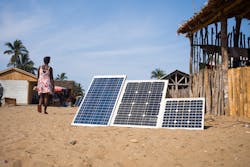Minigrid developers that are trying to electrify sub-Saharan Africa and other emerging areas face a serious math problem. At their current rate of progress, it will take 100 years for them to overcome energy poverty.
That’s the calculation of Husk Power, a leading minigrid developer in rural Asia and Africa, which is proposing a new industry business model to hasten progress. The plan is laid out in “Scaling Solar Hybrid Minigrids: An Industry Roadmap,” released last week.
The report defines minigrids as “community-based energy, where locating the generation of energy close to the end customer results in a more robust, reliable, resilient and lower-cost energy system.”
More than 700 million people still lack electricity and 3 billion have only unreliable power. The world needs another 200,000 minigrids to rectify the problem by 2030, and it’s only 10% of the way there, according to the report.
Companies are building about 1,000 projects per year. If they continue at that rate, it will take more than a century to end energy poverty, as envisioned by the United Nations Sustainable Development Goal 7 (SDG7). The UN would like to reach the goal by 2030.
“With a forecast of more than 100 years versus an SDG target of 8 years, the industry needs at least 10 companies building minigrids at 10 times the current pace to meet the need,” says the report.
Part of the problem is that companies struggle with finding profitable ways to build projects at scale.
“In spite of the urgent need, the minigrid industry has yet to produce a profitable company,” said the road map’s lead author Brad Mattson, who is chairman of Husk Power and board member of the Africa Minigrid Developers Association. “There are strong signs that the industry is maturing, but remaining barriers to sustainability and scale require a new level of ambition and clarity, and a proven formula with quantifiable metrics.”
The report lays out a road map to speed development that rethinks industry metrics, offering a detailed new approach that focuses on energy cost, quality and demand, rather than technology goals.
For example, it recommends that the industry focus on levelized cost of energy, adjusted for unique minigrid characteristics, rather than cost per connection (CPC), which is currently used in emerging markets. The report argues that government subsidies based on CPC lead to poor economic outcomes because they encourage developers to install as many minigrids as possible even where they will not be used.
“For sheer economics, it is far better for a minigrid developer to have one customer consuming 10,000 watts than having 100 customers each consuming 100 watts,” the report says.
The end goal is to create a profitable model so that minigrid developers can achieve a return on investment that will attract the approximately $127 billion needed before the end of the decade to build the minigrids.
Governments, investors and developers need to view the minigrid market differently as well. They tend to view it on the country level, when various levels of market maturity can be found within individual countries. Each market may require a different strategy and business model, according to the report.
The plan also focuses on driving demand, which the report says is the “Achilles’ heel” of the minigrid industry. People in emerging nations may want electricity but not have the appliances to use it.
The report is available for download here.







